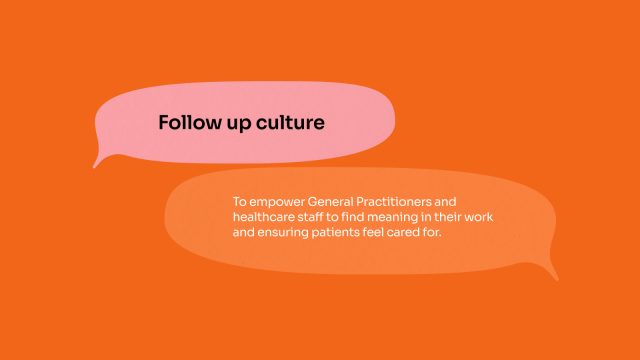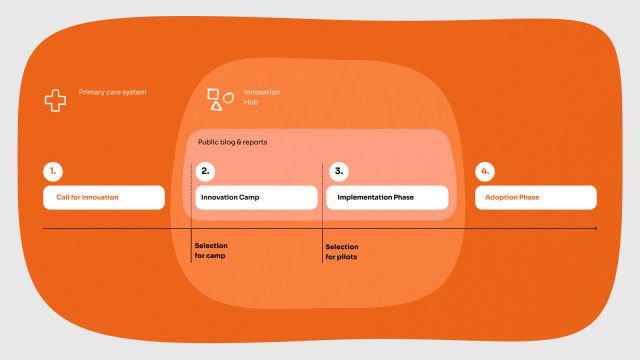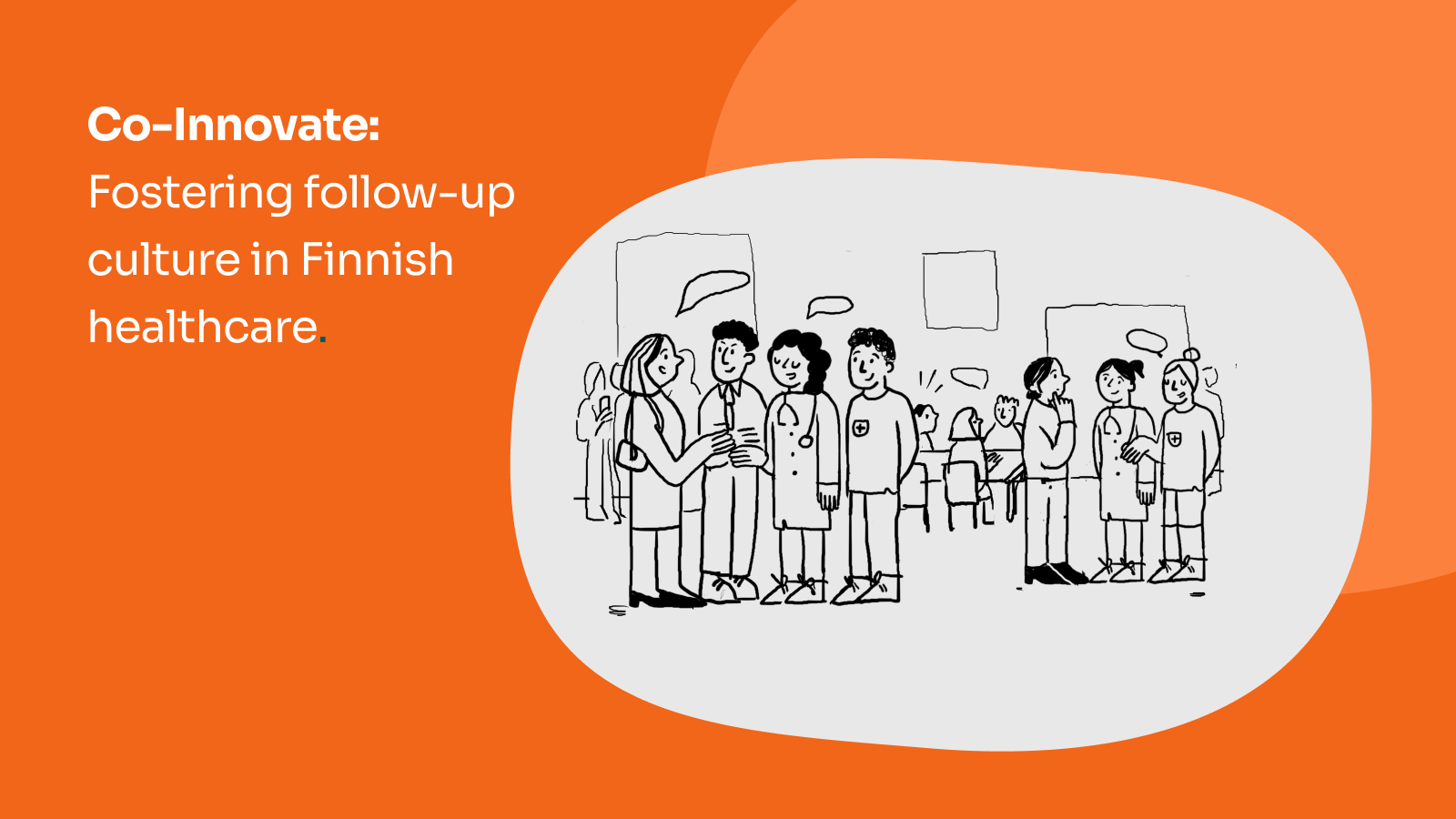This blog post provides an update on the ongoing work in the DfG course! The post is written by group 2C dealing with the Ministry of Social Affairs and Health’s brief on Continuity of Care as a new Kela reimbursement. The group members are Bhairavi Balasubramanian and Sofia Correia from the Master’s Programme in Collaborative and Industrial Design, and David Bertl and Tuomas Laakkonen from the Master’s Programme in Creative Sustainability.
Written by Sofia Correia
From A to B
“How did you go from wanting to improve patient feedback to a co-innovation programme?” asked one of the partners when we finished our presentation. “I mean it makes sense, but it is a bit outside of the box.”
I think I felt as clueless as him throughout the moment we decided that we wanted to improve follow-up care in the primary healthcare system in Finland. I was sure this was the right path to take, but I always asked myself: how? How are we doing this in a system focused on providing single-appointment services instead of continuous care? We had no clue how we were going to answer this big question, but we knew that the concept of follow-up would be the mechanism that could foster continuity of care and make medical staff and patients feel valued. So, we jumped into the unknown with confidence.
I think I felt as clueless as him throughout the moment we decided that we wanted to improve follow-up care in the primary healthcare system in Finland. I was sure this was the right path to take, but I always asked myself: how? How are we doing this in a system focused on providing single-appointment services instead of continuous care? We had no clue how we were going to answer this big question, but we knew that the concept of follow-up would be the mechanism that could foster continuity of care and make medical staff and patients feel valued. So, we jumped into the unknown with confidence.

Figure 1. Follow up Culture © Creative Commons CC by 4.0. 2024. Bhairavi Balasubramanian, Sofia Correia, David Bertl and Tuomas Laakkonen. Design for Government. Aalto University.
“The Strategy That Will Fix Health Care”
But, I have to admit, I was a bit scared. I started to read more articles, to see if I could find some renowned academics that could give us some clues on how to find sense in this fragmented system. I started to make notes of every article and book that Marco, part of the DfG teaching team, mentioned in class and in our tutoring sessions and finally I was introduced to Michael Porter and to his article “The Strategy That Will Fix Health Care” (Porter, 2013). Sounded promising. I started to get a bit obsessed with this guy, but this one turned out to be a good obsession.
Michael Porter is a professor at Harvard Business School specialized in economics, business strategy, and competitive advantage. He defends the idea of shifting from a volume-based system (focused on the quantity of services provided) to a value-based system (focused on patient outcomes). To do so, assessing and sharing outcomes inside and outside a team is essential for understanding what works and what should be improved to provide the best care delivery.
“Teams improve and excel by tracking progress over time and comparing their performance to that of peers inside and outside their organisation.” Michael Porter; Harvard Business Review 2013
And in the brief that we were given follow-up care needed to be improved. But how could we do it if it was not part of the culture or habits of the medical staff? And adding to this, the fact that health centres are so different in size, strategies and demographics? We needed first to allow healthcare teams to innovate and imagine how a “follow-up culture” would look for them, share their innovations and help other teams learn from these advancements. In the end, we would be able to map out the habits that would compose “follow-up culture” in the Finnish context and implement them across the country. In a nutshell, this was our idea.

Figure 2.The Kela Co-Innovation Programme Plan. © Creative Commons CC by 4.0. 2024. Bhairavi Balasubramanian, Sofia Correia, David Bertl and Tuomas Laakkonen. Design for Government. Aalto University.
“Government – investor, risk-taker, innovator”
So getting back to the first question, this is how we went from wanting to improve patient feedback to an innovation programme where teams come together to learn and share with each other innovative ways to implement follow-up methods.
But if this may respond to this question, it also creates some new ones. Do you know if this will work? Well, we know that Nesta also created a programme called Creative Councils (Cook & Steinberg, 2013) to help local governments innovate in order to tackle a long-term challenge that mattered to their communities. Our plan for the programme is based on Nesta’s strategy.
Ok, but really, Governments are not investors, risk-takers or innovators. That’s the idea we have about the public sector, right? The private sector is more innovative because it is able to think outside of the box. As Steve Jobs keeps on reminding us in his speech watched more than 30 million times: “To be innovative, stay hungry, stay foolish” (Jobs S. 2005).

Figure 3 . Private Sector vs Public Sector, © TEDGlobal 2013. Mariana Mazzucato.
Mariana Mazzucato, the “most important thinker about innovation” as The New Republic has called her (Judis, J.B, 2013), has a TED talk called “Government — investor, risk-taker, innovator”. It doesn’t have as many views as the Steve Jobs speech but it is still worth the time (Mazzucato, M. 2013).
In this TED Talk, Mariana Mazzucato explores the government’s critical role in driving innovation and economic growth. Mazzucato believes governments can be initial investors in innovations that the private sector might shy away from. This involves supporting early-stage research and development, even when success is not certain. For example, public venture-capital schemes such as the Small Business Innovation Research Initiative helped finance companies like Apple, Compaq and Intel during their early development stages. But we are not here to compare the U.S. government to European governments. We know that culturally, the USA has a more risk-taking attitude and is more prone to support early-stage experiments.
In our case, we are talking about supporting the system to innovate and not completely diving into the unknown. In Europe, there’s a greater emphasis on ensuring that public investments generate returns for the public, but this shouldn’t prevent them of not taking any actions towards creating radical solutions. To some degree, governments should be committed to fostering environments conducive to innovation.
Kela can maybe start considering improving continuity of care by providing incentives for innovation and best practices and facilitating the sharing of successful models across different healthcare settings. It can also collaborate with private organisations to foster innovation, which we also proposed for funding our programme
By embracing innovation, supporting continuous improvement through performance tracking, and fostering collaborations that enhance care delivery, we can achieve better health outcomes, improved patient and medical staff satisfaction, and reduced costs – ultimately moving us closer to continuity of care.
Remember,
“To be innovative, stay hungry, stay foolish.”
Steve Jobs, 2005
References
Porter, M., Lee, T. (2013). The Strategy That Will Fix Health Care. Harvard Business Review, https://hbr.org/2013/10/the-strategy-that-will-fix-health-care
Boyer B., Cook J. & Steinberg M. (2013) Legible practices, Six stories about the craft of stewardship, Sitra
Jobs, S. (2005). Steve Jobs’ 2005 Stanford Commencement Address [Video]. Standford Univeristy,
Judis, J.B. (2013). The Three Most Important Thinkers About Innovation You Need To Know, The New Republic, https://newrepublic.com/article/114395/three-most-important-thinkers-about-innovation-you-dont-know
Mazzucato, M. (2013) Mariana Mazzucato: Government — investor, risk-taker, innovator [Video]. TED Talks,
The DfG course runs for 14 weeks each spring – the 2024 course has now started and runs from 26 Feb to 29 May. It’s an advanced studio course in which students work in multidisciplinary teams to address project briefs commissioned by governmental ministries in Finland. The course proceeds through the spring as a series of teaching modules in which various research and design methods are applied to address the project briefs. Blog posts are written by student groups, in which they share news, experiences and insights from within the course activities and their project development. More information here about the DfG 2024 project briefs.

